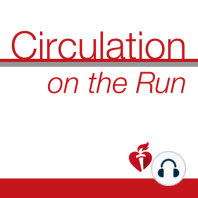16 min listen
Circulation September 29, 2020 Issue
ratings:
Length:
20 minutes
Released:
Sep 28, 2020
Format:
Podcast episode
Description
This week’s episode includes author Finnian Mc Causland and Associate Editor Justin Ezekowitz as they discuss angiotensin-neprilysin inhibition and renal outcomes in heart failure with preserved ejection fraction. TRANSCRIPT BELOW Dr Carolyn Lam: Welcome to Circulation on the Run, your weekly podcast summary and backstage pass to The Journal and its editors. I'm Dr Carolyn Lam, Associate Editor from the National Heart Center and Duke National University of Singapore. Dr Greg Hundley: And I'm Greg Hundley Associate Editor, director of the Pauley Heart Center at VCU Health in Richmond, Virginia. Dr Carolyn Lam: Greg, we're going to be talking about RNEs and renal outcomes in HFpEF. Oh, you got to hold me back this is going to be such an interesting discussion. But maybe let's grab our coffees. Are you ready to talk about some of the papers in today's issue? Dr Greg Hundley: You bet. Dr Carolyn Lam: Well the first paper I have really represents a novel gene therapy approach to atrial fibrillation. So doctors led by Dr Arora from Northwestern University Feinberg School of Medicine and colleagues used a novel gene therapy approach in a canine rapid atrial pacing model of atrial fibrillation to demonstrate that NADPH oxidase-2 or NOX2 generated oxidative injury by causing upregulation of a constitutively active form of acetylcholine-dependent potassium current, or IKH is an important mechanism underlying electrical remodeling in the fibrillating atrium. Dr Greg Hundley: Wow, Carolyn, very interesting. Tell us a little bit more about this gene therapy approach. Dr Carolyn Lam: They performed targeted expression of anti-NOX2 short hairpin RNA in the intact atria of the dogs, and then subjected those animals to rapid atrial pacing for a period of several weeks to months. The novel atrial gene therapy approach prevented the development of electrical remodeling and sustained atrial fibrillation thus demonstrating for the first time a clearer causative role for NOX2 generated oxidative injury in the creation, as well as the maintenance of electrical remodeling in atrial fibrillation. Furthermore, they demonstrate that a likely cellular and molecular mechanism by which oxidative injury created a vulnerable substrate for atrial fibrillation, the results of this study yield therefore valuable mechanistic insights into the pathogenesis of atrial fibrillation and have important therapeutic implications for this clinical management. Dr Greg Hundley: Very nice, Carolyn. We need more therapies for AFib. Boy, that's so informative. Well, the next paper that I have sort of merges the world of electrophysiology with the world of imaging and it comes to us from Dr Michela Casella from Centro Cardiologico Monzino. Among 162 consecutive patients, this study evaluated the combined utility of electroanatomic voltage mapping coupled with cardiovascular magnetic resonance imaging to guide endomyocardial biopsies. Dr Carolyn Lam: Oh, so interesting. A combined noninvasive and invasive electrical guide to perform cardiac biopsies, wow. So what did they find Greg? Dr Greg Hundley: So they found that the sensitivity of pooled electroanatomic voltage mapping and cardiovascular magnetic resonance was as high as 95%. EVM and CMR together conferred an endomyocardial biopsy positive predictive value of 89%. Endomyocardial biopsy analysis allowed to reach a new diagnosis different from the suspected diagnosis in 39% of patients, complication rates were low, mostly vascular access related, with no patients requiring urgent management. Most impressive for this manuscript are the illustrative figures that are provided. It's really a great article for those performing biopsies, doing imaging, or the EP procedures that guide the biopsy process. Dr Carolyn Lam: Really nice, Greg, thanks. Now for the last paper, have you ever thought about atherosclerosis as an autoimmune disease? Dr Greg Hundley: Well, I wonder, we're learning so much about our immune systems these days,
Released:
Sep 28, 2020
Format:
Podcast episode
Titles in the series (100)
Circulation August 30, 2016 Issue: Circulation Weekly: Your Weekly Summary & Backstage Pass To The Journal by Circulation on the Run
